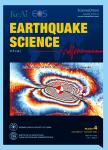Seismogenic tectonics of the Qian-Gorlos earthquake in Jilin Province,China
Seismogenic tectonics of the Qian-Gorlos earthquake in Jilin Province, China作者机构:Institute of Disaster PreventionLangfang 065201China Institute of GeologyChina Earthquake AdministrationBeijing 100029China Lanzhou Institute of SeismologyChina Earthquake AdministrationLanzhou 730000China
出 版 物:《Earthquake Science》 (地震学报(英文版))
年 卷 期:2016年第29卷第2期
页 面:93-103页
核心收录:
学科分类:0709[理学-地质学] 0819[工学-矿业工程] 07[理学] 070905[理学-第四纪地质学] 070801[理学-固体地球物理学] 0707[理学-海洋科学] 0818[工学-地质资源与地质工程] 0708[理学-地球物理学] 0815[工学-水利工程] 0816[工学-测绘科学与技术] 0813[工学-建筑学] 0825[工学-航空宇航科学与技术] 0704[理学-天文学] 0814[工学-土木工程]
基 金:supported by the National Natural Science Foundation of China under Grant No.41372216 the Major Projects of the Ministry of Finance under Grant No.201108001 the Fundamental Research Funds of the Central Universities under Grant No.20120102 and No.ZY20150303 the Teachers Fund of China Earthquake Administration under Grant No.2012001
主 题:Qian-Gorlos earthquake Historical earthquake Seismogenic structure
摘 要:The Qian-Gorlos earthquake, which occurred in the Songliao basin in Jilin Province in 1119 AD, was the largest earthquake to occur in NE China before the 1975 Haicheng earthquake. Based on historical records and surface geological investigations, it has been suggested previously that the earthquake epicenter was in the Longkeng area. However, other workers have considered the epicenter to be in the Halamaodu area based on the landslides and faults found in this region. No seismogenic structure has yet been found in either of these two *** tried to detect active faults in the urban areas of Songyuan City, where the historical earthquake was probably located. One of the aims of this work was to clarify the seismogenic structure so that the seismic risk in the city could be more accurately evaluated. The area was investigated and analyzed using information from remote sensing and topographic surveys, seismic data from petroleum exploration, shallow seismic profiles, exploratory geological trenches on fault outcrops, and borehole data. The geophysical data did not reveal any evidence of faults cutting through Cretaceous or later strata under the Longkeng scarp, which has been suggested to be structural evidence of the Qian-Gorlos earthquake. The continuous fault surfaces on the back edge of terraces in theHalamaodu area stretch for [3.5 km and were probably formed by tectonic activity. However, results from shallow seismic profiles showed that the faults did not extend downward, with the corresponding deep structure being identified as a gentle kink band. A new reverse fault was found to the west of the two suggested epicenters, which presented as a curvilinear fault extending to the west, and was formed by two groups of NE- and NW-trending faults intersecting the Gudian fault. Three-dimensional seismic and shallow seismic data from petroleum exploration revealed its distinct spatial distribution and showed that the fault may cut through Late Quaternary strata. E



